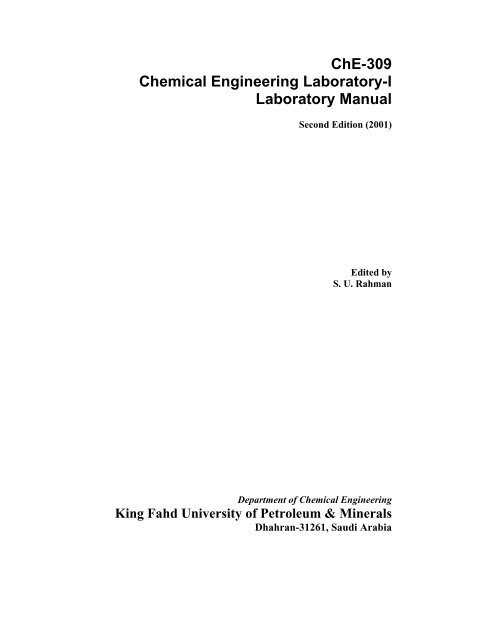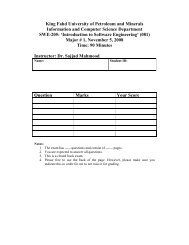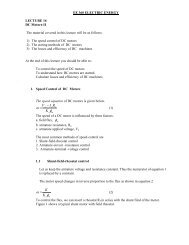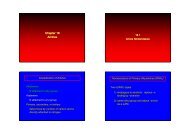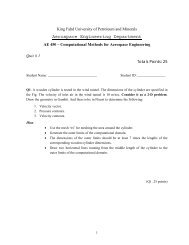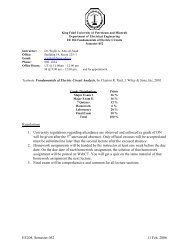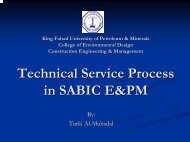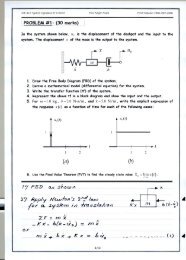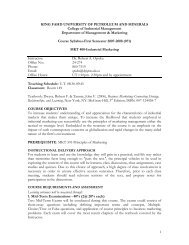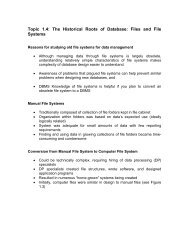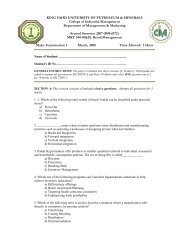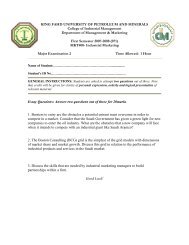ChE-309 Chemical Engineering Laboratory-I Laboratory Manual
ChE-309 Chemical Engineering Laboratory-I Laboratory Manual
ChE-309 Chemical Engineering Laboratory-I Laboratory Manual
Create successful ePaper yourself
Turn your PDF publications into a flip-book with our unique Google optimized e-Paper software.
<strong>ChE</strong>-<strong>309</strong><br />
<strong>Chemical</strong> <strong>Engineering</strong> <strong>Laboratory</strong>-I<br />
<strong>Laboratory</strong> <strong>Manual</strong><br />
Second Edition (2001)<br />
Edited by<br />
S. U. Rahman<br />
Department of <strong>Chemical</strong> <strong>Engineering</strong><br />
King Fahd University of Petroleum & Minerals<br />
Dhahran-31261, Saudi Arabia
Preface<br />
This laboratory manual is prepared by the department of chemical engineering<br />
for <strong>Chemical</strong> <strong>Engineering</strong> <strong>Laboratory</strong>-I (<strong>ChE</strong>-<strong>309</strong>). It is divided into three<br />
sections; namely, Fluid Mechanics, Heat Transfer and Mass Transfer. The<br />
purpose of this manual is to serve as instructional book for students, technical<br />
staff and instructors to assist in performing and understanding the experiments<br />
in Transport Phenomena. In the second edition, two new experiments on<br />
kinematic viscosity and vapor pressure determinations have been included in<br />
Fluid Mechanics and Mass Transfer sections respectively. The old<br />
experiments have been revised to eliminate errors and induce clarity. This<br />
manual will be available in electronic form from department’s official website,<br />
http://www.kfupm.edu.sa/che/labcourses.htm.<br />
Acknowledgement<br />
This laboratory manual has evolved over a long period of time and we<br />
acknowledge many names of the earliest contributors, which have been lost in<br />
antiquity. The major driving force of the present form of write-up was Dr.<br />
Alfred Guankel. The manual was refined and enriched by Dr. K. F. Loughlin.<br />
The first print edition was edited by Dr. W. Z. Khan. Other contributors of the<br />
previous editions were Dr. E. Alper, Dr. J. Beltramini, Prof. A. A. Shaikh,<br />
Prof. M. Shalabi, Mr. M. A. Chaudhary, Mr. A. Ibrahim, Mr. A. Jamal, Mr. U.<br />
El-Nafaty, Mr. N. Tukur, Mr. G. Yahya and Mr. S. Zaidi. Contributions from<br />
Mr. N. Tukur, Mr. A. Al-Juhani, Mr. S. Zaidi in the second editions are<br />
appreciated. Prof. A. A. Shaikh contributed the two new experiments.<br />
Editorial assistance by Mr. S. Saifuddin is highly appreciated.<br />
We are greatly indebted to many publications for using their material as<br />
reference and they have been appropriately cited. Finally the support offered<br />
by the department chairman, valuable comments from fellow faculty and<br />
assistance provided by the department secretaries in typing the original<br />
manuscript are highly acknowledged.<br />
(i)
Table of Contents<br />
Preface .............................................................................................................. (i)<br />
Acknowledgement ........................................................................................... (i)<br />
Table of Contents ............................................................................................ (ii)<br />
Safety in the <strong>Laboratory</strong> .................................................................................(iii)<br />
Instructions for Preparing <strong>Laboratory</strong> Reports .............................................. (vi)<br />
The Lab Course Website ................................................................................ (ix)<br />
Fluid Mechanics:<br />
EXPERIMENT No. F2: Flow through Packed Beds .......................................1<br />
EXPERIMENT No. F3: Fluidized Bed .........................................................12<br />
EXPERIMENT No. F4: Flow Meter Calibration Rig ....................................19<br />
EXPERIMENT No. F5: Losses in Piping Systems ........................................29<br />
EXPERIMENT No. F6: Sedimentation Studies ............................................43<br />
EXPERIMENT No. F8: Determination of Kinematic Viscosity of<br />
Transparent and Opaque Liquids (ASTM D445) ............................................51<br />
Heat Transfer:<br />
EXPERIMENT No. H1: Heat Transfer by Conduction .................................58<br />
EXPERIMENT No. H3: Film and Dropwise Condensation on<br />
Vertical Tubes ..................................................................................................67<br />
EXPERIMENT No. H4: Heat Transfer in a Double<br />
Pipe Heat Exchanger ........................................................................................81<br />
EXPERIMENT No. H6: Heat Transfer in a Shell and Tube<br />
Heat Exchanger ................................................................................................90<br />
EXPERIMENT No. H7: Heat Transfer by Free and Forced<br />
Convection .....................................................................................................101<br />
EXPERIMENT No. H8: Computer Linked Cross Flow<br />
Heat Exchanger ..............................................................................................110<br />
Mass Transfer:<br />
EXPERIMENT No. M1: Molecular Diffusion in Gases .............................121<br />
EXPERIMENT No. M2: Physical Gas Absorption in a Packed-<br />
Column Absorber ...........................................................................................132<br />
EXPERIMENT No. M3: Diffusion in a Porous Media: Dynamic<br />
Experiment with a Single Pellet .....................................................................142<br />
EXPERIMENT No: M5: Effect of Agitation on Solid Liquid Mass<br />
Transfer ..........................................................................................................152<br />
EXPERIMENT No. M7: Molecular Diffusion in Liquids ............................160<br />
EXPERIMENT No. M8: Drying of Solids ................................................175<br />
EXPERIMENT No. M9: Vapor Pressure by Reid Method<br />
(ASTM D 323) .............................................................................................186<br />
(ii)
Safety in the <strong>Laboratory</strong><br />
Preparation<br />
Before starting any laboratory operation ask and answer the following<br />
questions by yourself:<br />
1. Have I done this before<br />
2. Do I have the proper equipment<br />
3. Does anything look wrong<br />
4. What are the hazards<br />
5. Should I work in a fume hood<br />
6. Do I need goggles or other safety equipment<br />
7. Do I need additional help<br />
8. Should I check further with my instructor<br />
9. Have I planned this experiment or exercise<br />
10. Do I know what to do, if there is an accident<br />
11. Do I know where the fire extinguishers are located<br />
LABORATORY SAFETY RULES<br />
1. NO SMOKING IN THE LABORATORY:<br />
2. Safety glasses will be worn at all times where applicable during<br />
laboratory periods. These glasses will be kept between laboratory<br />
sessions in the racks provided.<br />
3. Wear apron (lab overall) in the lab when running apparatus and<br />
handling liquids.<br />
4. Wear rubber gloves when handling liquids.<br />
5. When dangerous chemicals are in use, a second person should be<br />
within call.<br />
6. Find out the location of First Aid Box.<br />
7. Before operating any valve, switch, etc., know precisely what the<br />
effect of your manipulation will be.<br />
8. Turn off all the valves on cylinders of compressed or liquefied gases<br />
when not in use.<br />
9. Students are not allowed to open gas cylinders. Ask the technician.<br />
(iii)
10. Report all injuries to instructor and to KFUPM doctor immediately.<br />
Dial 3333.<br />
11. Attach a label "Please leave on" on fittings, you need "on" for long<br />
time.<br />
12. Keep all inflammable liquids or gases away from open electrical<br />
equipment and other sources of ignition.<br />
13. Gas cylinders must be kept in a stand or chained vertically to a bench.<br />
14. Avoid inhalation of gases or vapors of any kind, especially<br />
Methanol Acetone Cyanides<br />
Benzene Chlorine Metal Carbonyls<br />
Aniline Bromine Carbon monoxide<br />
Carbon bisulfide Chlorinated hydrocarbons Phosgene<br />
Nitrobenzene Hydrogen sulfide Arsenic<br />
Compounds<br />
Nitric acid (the higher the concentration, Org: compounds<br />
of Cl, Br, I, the lesser the order)<br />
Mercury<br />
NO2, NH2 & CN<br />
Benzene<br />
Oxalates<br />
15. Do not leave cables trailing across the floor of lab.<br />
16. Practice good housekeeping. Clean all spills at once. Return all<br />
equipment to proper storage when not in use. Place all trash in<br />
appropriate receptacles.<br />
17. Avoid direct blasts of air on the skin from high-pressure compressed<br />
air lines. Never play with air hoses.<br />
18. Use special vacuum cleaner from laboratory for immediate removal of<br />
mercury spills. Arrangement should be made to contain mercury.<br />
19. Make sure any system being heated is properly vented.<br />
20. Know the location and use of all emergency, protective, and fire<br />
fighting equipment.<br />
21. Do not smell directly any chemical being heated.<br />
22. Remember that, if a lab smells, do not use it. Inform instructor/lab<br />
technician.<br />
23. Do not leave lab while apparatus is on, always inform instructor if you<br />
are in a situation to leave the lab.<br />
(iv)
24. When working above others, be especially careful not to drop tools.<br />
25. Do not wear loose clothing or neckties when working with machinery.<br />
You will not be allowed to enter the lab if you are in loose dress or not<br />
wearing covered shoes.<br />
26. Report to the instructor any conditions that are safety hazards.<br />
27. All power wiring is to be installed by an approved electrician.<br />
28. All forms of asbestos should be treated as dangerous.<br />
29. Keep the lab tidy.<br />
30. Always remember: SAFETY IS GOOD TECHNIQUE!<br />
(v)
Instructions for Preparing <strong>Laboratory</strong> Reports<br />
The report must be prepared and will be graded according to the<br />
following outline:<br />
Subject<br />
Marks<br />
1. Title page 2<br />
2. Abstract 12<br />
3. Introduction 3<br />
4. Theoretical Background 5<br />
5. Procedure 4<br />
6. Results 8<br />
7. Discussion of Results 24<br />
8. Conclusions and Recommendations 8<br />
9. Literature Cited 2<br />
10 Nomenclature 2<br />
Appendices<br />
A1 Raw Data 5<br />
A2 Analysis of data & Sample 20<br />
Calculation<br />
Organization & neatness 5<br />
Total: 100<br />
1. Title Page<br />
The Title page should be separate from the rest of the report. It should contain:<br />
a. The name of the experiment<br />
b. The number of course<br />
c. The date when the experiment was run<br />
d. The name of the writer and his co-workers, ID number, and his<br />
group number<br />
e. The name of the instructor to whom the report is submitted<br />
f. The date of submission of report<br />
(vi)
2. Abstract<br />
The abstract should be informative, and should be written in about three to<br />
five sentences. It should cover all phases of the investigation. It must include<br />
the following:<br />
a. An introductory statement about the subject matter<br />
b. Briefly describe what was done.<br />
c. Present some selected result (numerical values, if possible).<br />
d. If possible, present some percentage errors in experimental<br />
results in comparison with theoretical values.<br />
While writing the abstract, it should be kept in mind that you should not refer<br />
to any graph or table.<br />
3. Introduction<br />
This section should include few sentences discussing the physical and/or<br />
chemical principles involved in the experiment.<br />
4. Theoretical Background<br />
This section should include the theory behind the experiment. It should also<br />
contain all those equations, which are used to acquire a certain result.<br />
Theoretical correlatios, which are used for comparison with experimental<br />
results, should also be included.<br />
5. Procedure<br />
Here, you should briefly describe the actual step-by-step procedure you<br />
followed in running the experiment. It should be written in your own words,<br />
e.g. the needle valve was manipulated in order to adjust the liquid flow rate.<br />
6. Results<br />
The results should be presented in the form or Tables or graphs. The Table<br />
should contain the results obtain from experiments and from theoretical<br />
knowledge. Comparisons should be presented in terms, e.g. percent deviation.<br />
(vii)
7. Discussion of Results<br />
In this section you should discuss you experimental results. Show how you<br />
make comparison with the values obtained theoretically. Also discuss the<br />
deviation of experimental results from theoretical values. The possible source<br />
of errors should also be mentioned. If the results are obtained in terms of<br />
graphs, then interpret them also.<br />
8. Conclusions and Recommendations<br />
Conclusions are the series of numbered sentences which answer the questions<br />
posed in the end of each experiments. Conclusions should also include the<br />
errors between the experimental and theoretical values. What you have learned<br />
from the experiment should be mentioned as well.<br />
Recommendations are the proposals for future work, e.g. suggested changes in<br />
equipment, study of new variables, or possible experiments in relative fields.<br />
Like the conclusions, the recommendations are usually listed by numbers, and<br />
each consists of only a sentence or two.<br />
9. Literature Cited<br />
Here, you should list the books, Journal’s articles, etc. used in writing your<br />
report and analyzing the experiment. The reference should be completed<br />
(name of the book, author, volume, date of publication, pages, etc.).<br />
References should be arranged alphabetically by author.<br />
10. Nomenclature<br />
The symbols, which are used in the report, should be defined in the<br />
nomenclature in alphabetical order. The accompanying definitions must<br />
include proper units.<br />
Appendices<br />
All appendices and graphs should be attached at the end of the report.<br />
A1. Raw Data:<br />
It should contain the data on which the experiment was done.<br />
A2. Analysis of Data and Sample Calculations:<br />
This shows how the data/manipulated data is transformed into experimental<br />
results by using the appropriate equations. Also, how the theoretical results are<br />
(viii)
obtained using theoretical in terms of percentage error. Sample calculations<br />
should contain each step, which is used to acquire certain results.<br />
Organization and Neatness<br />
The students must organize their reports in a manner as mentioned earlier. It is<br />
required/encouraged to use EXCEL, SIGMAPLOT, HARVARD, GRAPHICS<br />
OR AND OTHER AVAILABLE GRAPHIC SOFTWARE PACKAGES to<br />
draw graph. The neatness will include how the student has written the report.<br />
Additional points will be given to those students who use GRAPHIC<br />
SOFTWARE PACKAGES to draw graph.<br />
The Lab Course Website<br />
http://www.kfupm.edu.sa/che/labcourses.htm<br />
This website is a part of the department’s official website. It is designed to<br />
provide relevant information to the students and instructors. This site has the<br />
lab manuals in electronic form, a discussion page, lab schedules, exam<br />
schedules, informative links and final grades. All related notices would be<br />
posted on this site. Please visit this site frequently.<br />
(ix)


